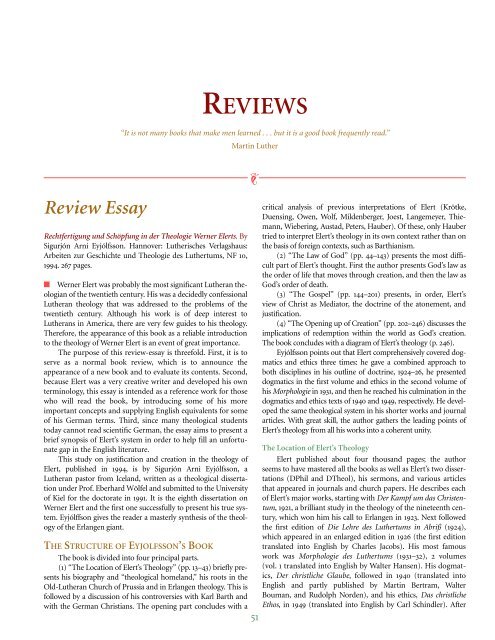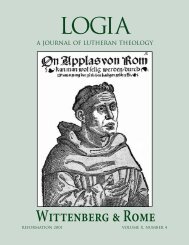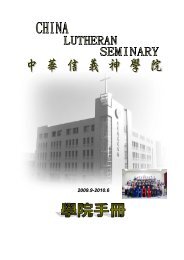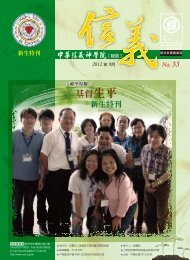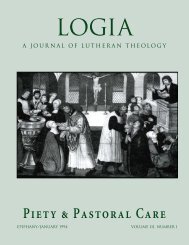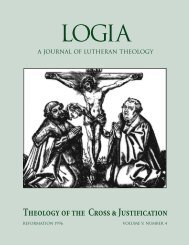04-2 Hermeneutics.pdf
04-2 Hermeneutics.pdf
04-2 Hermeneutics.pdf
- No tags were found...
You also want an ePaper? Increase the reach of your titles
YUMPU automatically turns print PDFs into web optimized ePapers that Google loves.
REVIEWS“It is not many books that make men learned . . . but it is a good book frequently read.”Martin LutherReview EssayRechtfertigung und Schöpfung in der Theologie Werner Elerts. BySigurjón Arni Eyjólfsson. Hannover: Lutherisches Verlagshaus:Arbeiten zur Geschichte und Theologie des Luthertums, NF 10,1994. 267 pages.■ Werner Elert was probably the most significant Lutheran theologianof the twentieth century. His was a decidedly confessionalLutheran theology that was addressed to the problems of thetwentieth century. Although his work is of deep interest toLutherans in America, there are very few guides to his theology.Therefore, the appearance of this book as a reliable introductionto the theology of Werner Elert is an event of great importance.The purpose of this review-essay is threefold. First, it is toserve as a normal book review, which is to announce theappearance of a new book and to evaluate its contents. Second,because Elert was a very creative writer and developed his ownterminology, this essay is intended as a reference work for thosewho will read the book, by introducing some of his moreimportant concepts and supplying English equivalents for someof his German terms. Third, since many theological studentstoday cannot read scientific German, the essay aims to present abrief synopsis of Elert’s system in order to help fill an unfortunategap in the English literature.This study on justification and creation in the theology ofElert, published in 1994, is by Sigurjón Arni Eyjólfsson, aLutheran pastor from Iceland, written as a theological dissertationunder Prof. Eberhard Wölfel and submitted to the Universityof Kiel for the doctorate in 1991. It is the eighth dissertation onWerner Elert and the first one successfully to present his true system.Eyjólffson gives the reader a masterly synthesis of the theologyof the Erlangen giant.THE STRUCTURE OF EYJOLFSSON’S BOOKThe book is divided into four principal parts.(1) “The Location of Elert’s Theology” (pp. 13–43) briefly presentshis biography and “theological homeland,” his roots in theOld-Lutheran Church of Prussia and in Erlangen theology. This isfollowed by a discussion of his controversies with Karl Barth andwith the German Christians. The opening part concludes with a51critical analysis of previous interpretations of Elert (Krötke,Duensing, Owen, Wolf, Mildenberger, Joest, Langemeyer, Thiemann,Wiebering, Austad, Peters, Hauber). Of these, only Haubertried to interpret Elert’s theology in its own context rather than onthe basis of foreign contexts, such as Barthianism.(2) “The Law of God” (pp. 44–143) presents the most difficultpart of Elert’s thought. First the author presents God’s law asthe order of life that moves through creation, and then the law asGod’s order of death.(3) “The Gospel” (pp. 144–201) presents, in order, Elert’sview of Christ as Mediator, the doctrine of the atonement, andjustification.(4) “The Opening up of Creation” (pp. 202–246) discusses theimplications of redemption within the world as God’s creation.The book concludes with a diagram of Elert’s theology (p. 246).Eyjólfsson points out that Elert comprehensively covered dogmaticsand ethics three times: he gave a combined approach toboth disciplines in his outline of doctrine, 1924–26, he presenteddogmatics in the first volume and ethics in the second volume ofhis Morphologie in 1931, and then he reached his culmination in thedogmatics and ethics texts of 1940 and 1949, respectively. He developedthe same theological system in his shorter works and journalarticles. With great skill, the author gathers the leading points ofElert’s theology from all his works into a coherent unity.The Location of Elert’s TheologyElert published about four thousand pages; the authorseems to have mastered all the books as well as Elert’s two dissertations(DPhil and DTheol), his sermons, and various articlesthat appeared in journals and church papers. He describes eachof Elert’s major works, starting with Der Kampf um das Christentum,1921, a brilliant study in the theology of the nineteenth century,which won him his call to Erlangen in 1923. Next followedthe first edition of Die Lehre des Luthertums in Abriß (1924),which appeared in an enlarged edition in 1926 (the first editiontranslated into English by Charles Jacobs). His most famouswork was Morphologie des Luthertums (1931–32), 2 volumes(vol. 1 translated into English by Walter Hansen). His dogmatics,Der christliche Glaube, followed in 1940 (translated intoEnglish and partly published by Martin Bertram, WalterBouman, and Rudolph Norden), and his ethics, Das christlicheEthos, in 1949 (translated into English by Carl Schindler). After


